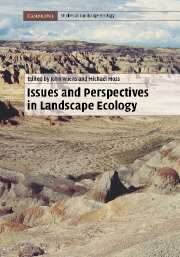Book contents
- Frontmatter
- Contents
- List of contributors
- Preface
- PART I Introductory perspectives
- PART II Theory, experiments, and models in landscape ecology
- PART III Landscape patterns
- PART IV Landscape dynamics on multiple scales
- PART V Applications of landscape ecology
- PART VI Cultural perspectives and landscape planning
- 26 The nature of lowland rivers: a search for river identity
- 27 Using cultural knowledge to make new landscape patterns
- 28 The critical divide: landscape policy and its implementation
- 29 Landscape ecology: principles of cognition and the political–economic dimension
- 30 Integration of landscape ecology and landscape architecture: an evolutionary and reciprocal process
- 31 Landscape ecology in land-use planning
- PART VII Retrospect and prospect
- Index
- Plate section
- References
30 - Integration of landscape ecology and landscape architecture: an evolutionary and reciprocal process
from PART VI - Cultural perspectives and landscape planning
Published online by Cambridge University Press: 20 November 2009
- Frontmatter
- Contents
- List of contributors
- Preface
- PART I Introductory perspectives
- PART II Theory, experiments, and models in landscape ecology
- PART III Landscape patterns
- PART IV Landscape dynamics on multiple scales
- PART V Applications of landscape ecology
- PART VI Cultural perspectives and landscape planning
- 26 The nature of lowland rivers: a search for river identity
- 27 Using cultural knowledge to make new landscape patterns
- 28 The critical divide: landscape policy and its implementation
- 29 Landscape ecology: principles of cognition and the political–economic dimension
- 30 Integration of landscape ecology and landscape architecture: an evolutionary and reciprocal process
- 31 Landscape ecology in land-use planning
- PART VII Retrospect and prospect
- Index
- Plate section
- References
Summary
Landscape architecture is a professional field that is significantly focused on landscape pattern – the spatial configuration of landscapes at many scales. Landscape architecture is informed by scientific knowledge and aspires to provide aesthetic expressions in landscapes across a range of spatial scales. Landscape ecology has been defined as the study of the effect of landscape pattern on process, in heterogeneous landscapes, across a range of spatial and temporal scales (Turner, 1989). The logical reasons for integrating these two fields are clear and compelling, with a great potential to support sustainable landscapes through ecologically based planning and design.
The integration of landscape ecology and landscape architecture holds great promise as a long-awaited marriage of basic science and its application; of rational and intuitive thinking; of the interaction of landscape pattern and ecological process over varied scales of space and time, with explicit inclusion of the “habitats,” activities, and values of humans. To the optimistic, this integration promises to provide a robust and appropriate basis for planning and design of sustainable environments. The focus on application is integral to most definitions of landscape ecology but has been slow to gain complete acceptance, or to demonstrate widespread success in “real world” landscape architectural applications. Unfortunately, the promise of integration remains more of a goal than a reality at this time.
I believe it is instructive to see the integration of landscape ecology and landscape design as an evolutionary, three-stage process (Fig. 30.1).
- Type
- Chapter
- Information
- Issues and Perspectives in Landscape Ecology , pp. 307 - 315Publisher: Cambridge University PressPrint publication year: 2005
References
- 7
- Cited by



